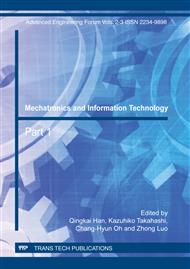p.281
p.285
p.291
p.296
p.302
p.308
p.314
p.320
p.324
Kinematic Analysis of Three-Wire-Driven Parallel (TWDP) Robot
Abstract:
In the paper, a novel new gravity-constrained (GC) three-wire-driven (TWD) parallel robot is proposed. With its mechanism model, three typical kinematics analytical models, including horizontal up-down motion, pitching motion and heeling motion and their corresponding simulations are given in detail. In static analysis, the change of tensions in the wires is calculated based on previous kinematics analysis. The simulation results show the robot has good movement stability. The paper can provide useful materials to study of dynamics and control on wire-driven robot.
Info:
Periodical:
Pages:
302-307
Citation:
Online since:
December 2011
Authors:
Keywords:
Permissions:
Share:
Citation:


